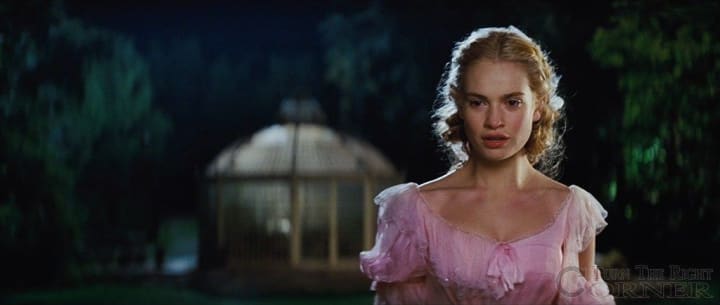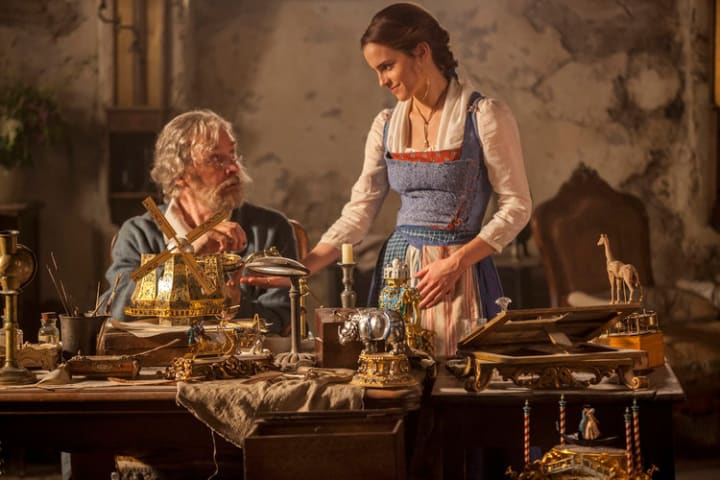
In the era of Disney reboots we are currently living in, we're essentially getting the same stories retold from a new perspective. Which is fine and in the hands of the right screenwriter, characters and plots can be interpreted in new and exciting ways. However, two Disney classics I have drastically different views on - both from my childhood and again revisited in my adulthood. We'll be taking a look at Beauty & the Beast and Cinderella, how both adaptations drastically differ from their origin films and how both portray feminism within a patriarchal and fantasy world.
Naturally, today's character studies will look at Cinderella and Belle from their respective 2015 and 2017 films. However, it's only right to look back on Ilene Woods and Paige O'Hara's animated reincarnations in the 50s and 90s. Both characters had massive impacts on Walt Disney's future - one saving the company from financial ruin and the other revolutionising how Disney's female leads were written.
During the mid to late 1940s, Walt Disney Productions had suffered financially after losing connections to the European film markets due to the outbreak of World War II. During this time, the studio endured box office failures such as Pinocchio (1940), Fantasia (1940), and Bambi (1942), all of which would later become more successful with several re-releases in cinemas and on home video.
Due to this, the studio was over $4 million in debt and was on the verge of bankruptcy. Walt Disney and his animators returned to feature film production in 1948 after producing a string of package films with the idea of adapting Charles Perrault's Cendrillon into an animated film. After two years in production, Cinderella was released by RKO Radio Pictures on 15th February 1950. It became the greatest critical and commercial hit for the Disney studio since the first full-length animated film Snow White and the Seven Dwarfs (1937) and helped reverse the studio's fortunes.
In terms of writing and characterisation, Disney's Cinderella and Snow White were vastly similar in their passivity. Both women were portrayed as a sign of the times, finding joy in domestic life and have rather simplistic and underdeveloped love stories where they ultimately become the damsel who needs saving despite being the protagonist. This carried over into Sleeping Beauty (1959 film), but they followed quite a straight-forward fairy tale format - Cinderella's happily ever after is found through her Prince Charming and love at first sight.

After years of failed start-ups and scraped scripts, Disney finally got a fresh take on the tale as old as time in the late 80s. Walt Disney Studios chairman Jeffrey Katzenberg commissioned Beauty and the Beast as an animated musical with a strong heroine and hired first-time screenwriter Linda Woolverton to write it. Basing her on the heroine of Jeanne-Marie Leprince de Beaumont's 1756 fairy tale "Beauty and the Beast", Woolverton adapted Belle into a stronger and less passive character for this film. Inspired by the women's rights movement and Little Women's Jo March, Woolverton wanted Belle to be a unique Disney heroine different from The Little Mermaid's popular (albeit boy-crazy and later mute) Ariel, and thus deliberately conceived the character as a feminist in an effort to avoid the criticism Disney had long been receiving due to the studio's reputation of depicting its female characters as victims.
Belle's strength and love of reading made her instantly stand out among past Disney protagonists, here the writers instilled the adventure-seeking heroine with goals and aspirations beyond romance. The love story between O'Hara's Belle and Robby Benson's Beast was a gradual one, starting off as hostile and later developing into friendship and then love. This was one of the first progressive romantic pairings in Disney, both characters have moments of character development as individuals and as a couple and even have moments of saving each other - Beast rescuing Belle from a pack and Belle tending to his wounds and pulling him to safety in the film's final battle - therefore, Belle was the first Disney protagonist to embrace the archetype of an active heroine.

So, how do these films differ with a new cast, crew and in live-action form? Well, Kenneth Branagh's Cinderella opted to go for a period drama retelling without any music numbers and the fantasy elements weaved in. As someone who wasn't a fan of the original animated Disney movie, I actually really liked this film and thought it was had much more depth to it.
What I really liked about Lily James' portrayal of Ella (Cinderella) is the realism and emotion she brought to her character and this made her a much stronger heroine, the fact she is still kind and even forgiving when she has suffered emotional abuse for years shows a maturity that is rarely seen in Disney movies.
I previous touched upon this adaptation in my Writing: Evil Mothers, when looking at the Stepmother's arc and how Ella and Stepmother's conflict ultimately ends with Ella finding the strength to forgive and let go of the past. James' Ella is more endearing and grounded than her original counterpart - looking at the scene where Cinderella's dress is torn before the ball, both counterparts have different tones and reactions.
In the 1950s version, Cinderella's dress is made of old material - with the help of the manor's local mice - and the stepsisters spitefully (and brutally) rip the dress, whereas the stepmother watches coldly in the shadows. It is a cruel act and Cinderella flees in tears until the Fairy Godmother appears. Cinderella entered this scene rather flamboyantly making a spectacle of herself, not realising the reactions of her stepmother until it was glaringly obvious which showed a certain naivety.
In the 2015 remake, Ella's dress has more of a sentimental value as it belonged to her mother and she took the time to sew the adjustments herself. Even when she enters the scene, she tentatively coughs to make her presence known and her first words are "It cost you nothing." - which demonstrated her character knew what response she would get and instantly went into reassurance mode. The cruelty that transpires hurts the protagonist on a deeper level, because one of the few reminders of her mother is destroyed and she is rejected openly as being seen as a member of this new family she finds herself in.
Yet despite being at her lowest point, Ella still shows kindness to an old beggar woman who turns out to be her Fairy Godmother. Screenwriter Chris Weitz's script crafts an active protagonist, a much more believable romance and a story familiar enough and still has a fresh take to make this a justifiable remake.

While the latter chose to reinterpret the narrative, Bill Condon directed Beauty & the Beast from a screenplay by Stephen Chbosky and Evan Spiliotopoulos that was true to word faithful to the source material, fully embracing its Broadway origins. This film followed Woolverton's script very closely, almost word for word sometimes and it made for nostalgic viewing - but there was one aspect of Emma Watson's Belle that really bothered me.
As well as being a bibliophile, Belle in this version was an inventor - taking the character trait that was originally her father Maurice's, instead writing him as an artist. This change I initially liked, because it had the potential to demonstrate how much similarities Maurice shares with his daughter and there was even a scene that portrayed this dynamic nicely, but the inventor arc goes nowhere for Belle.
In a scene in the town square, Belle builds essentially a washing machine with a donkey moving the mechanics while she teaches a little girl to read. The townsfolk go on a misogynistic rant, destroy her invention and ridicule her knowledge and wanting to teach other girls to read. The inventor arc is never visited again after this scene, but the more interesting aspect of that scene was Belle's love of reading, her wanting to share it and then being verbally attacked by small-minded villagers to side-step a sexist proposal from Luke Evans' Gaston.
It was a shame, it felt like the screenwriters wanted to give Belle something to do without following it through, it did not serve the plot or even her as a character. This was actually a suggestion made by Emma Watson herself, that the writers wrote in - my issues with this is that it should have been weaved more into the story and not just included in one scene. In an interview with Entertainment Weekly, Watson said:
“In the animated movie, it’s her father who is the inventor, and we actually co-opted that for Belle, I was like, ‘Well, there was never very much information or detail at the beginning of the story as to why Belle didn’t fit in, other than she liked books. Also what is she doing with her time?’ So, we created a backstory for her, which was that she had invented a kind of washing machine, so that, instead of doing laundry, she could sit and use that time to read instead. So, yeah, we made Belle an inventor.”
All of this is fine, but like Cinderella's selflessness or Belle's independence of mind or passion for reading, the inventor arc had to develop the character or plot - in this case, it did neither and the creatives can't rely on telling when they clearly aren't showing this side of Belle's character.

As a child, I absolutely loved the animated Beauty & the Beast and probably watched that on repeat I most definitely broke the VHS back in the day. Whereas the remake stuck so closely to the plot and barely deviated, it was a beautiful production but definitely played on nostalgia. Cinderella's films feel very different and upon comparison, I think the remake of Cinderella is better and the original Beauty is better than the remake. However, both are equally enjoyable for audiences young and old.
Vocal is having a limited time $1/71p deal for the first month for new signups to Vocal Plus.
This site has really kept me motivated in writing outside script work and analysing screenwriting and storytelling from multiple angles. There are many different communities and themes, so there's plenty of reading material if you have writers block. Follow this link and get writing!






Comments
There are no comments for this story
Be the first to respond and start the conversation.